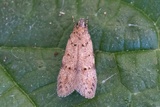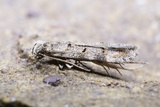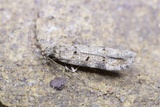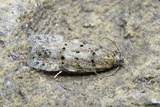Pseudotelphusa aenigma (Sattler, 1983) Species
Last modified: May 14, 2024, 5:32 p.m.
For the first time recorded from Belgium at Maasmechelen (LI) in 2019, confirmed by examination of its genitalia. This species can easily be confused with its congeners Pseudotelphusa paripunctella and Teleiodes wagae and the genitalia should be studied. The species is mainly known from the southern parts of Central Europe, though not from most of the Mediterranean countries.
Details
- Classification
- Family: Gelechiidae > Subfamily: Gelechiinae > Tribus: Litini > Genus: Pseudotelphusa > Species: Pseudotelphusa aenigma
- Vernacular names
- Sobere smalpalpmot (NL)
- First mention in Belgium
- Steeman C. & Sierens T. 2020. Interessante waarnemingen van Lepidoptera in België in 2019 (Lepidoptera) — Phegea 48(2): 26–40. On page 31. view page
- Status
-
Native
A healthy population is present in some heathland areas in LI.
Distribution
Imago
Wingspan 9,5–15 mm.
This species is externally very similar to Pseudotelphusa paripunctella, fresh specimens of this species can usually recognized by the presence of two pair black dots on the thorax which are absent or indistinct in Pseudotelphusa aenigma.
Bionomics
The larva usually spins two leaves together and constructs in this shelter a silken tube from where it feeds. It eats only the unexposed part of the parenchyma so at not to expose its presence.
Flight periods
The adults have been seen from late April towards late June.
Habitat
Forest-steppe, heathland.





